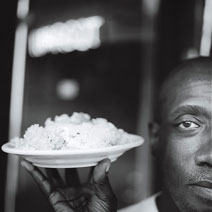But focus too much on restaurants and we’ll miss what’s best about the upper Manhattan eating experience: the street food. This, in my mind, is what distinguishes El Alto, what makes it singular: Of all the communities in Manhattan, no one else is throwing down the quantity or quality of street cuisine that Dominicans are throwing down. It’s on some Rise-of-David-Levinsky-type level. (That’s when as a community you know you’ve made it: When you’ve got as many people selling good grub on the streets as you do inside the restaurants.) A couple months ago I was standing on the corner of Dyckman and Seaman, waiting for my cousin Manny to join me for dinner. Washington Heights was doing its amazing spring thing. Crazy stunting. So many kids in baseball uniforms you would have thought we were in an earlier America. And the food vendors everywhere. Pushing weary shopping carts loaded with coolers and jugs. Wrestling napkins around their tasty products. Sometimes working in pairs, sometimes alone. Baseball caps, fanny packs, trailing the smell of fritura. A constant flow of street-food vendors, and even though I’m going to a “nice” place for dinner, I can’t resist. I buy a kipe, an alcapurria, and a pastelito de pollo in quick succession; if I’d been less disciplined I would have had a yaniqueque and a couple of pieces of pork chicharrón as well, but that would have put an end to dinner. Gulped down a glass of tamarind juice (which has the reputation in my country of making you sleepy). Could have had parcha, but men are not supposed to drink parcha (another saying). One of the sisters even had mabí, the original Taino root beer! (Your bodies are gone, ancestors, but not your recipes.) I’m a glutton for mabí, so I drank that too. Was not as good as I’m used to, but still.
The best of these vendors do bang-out business, summer and winter. The kipe man pulled out a wad of bills that would have made even Juvenile blush. They trawl the salons, bodegas, barbershops; they patrol the baseball games, the picnics, the parks, have their territories, their corners, their schedules. And as usual: Everybody I know has a favorite. My ex-girl will not buy a pastelito from anybody but this dude Seguidillo, whose reputation in the Heights is legendary. My current girl’s aunt is a street vendor famous for putting the most meat into her pastelitos. When the fam tried to convince her to cut back in order to increase her profits, she refused, claiming her customers expected no less from her. (I’ve actually tasted these pastelitos: delicious, of course, but more like calzones than fritura.) For majarete, my boy Pedro swears by La Vieja de Las Arepas, up on 181st and St. Nicholas. At Easter she also dishes up the best habichuelas con dulce this side of the Septentrionales (though there are at least three other women who lay claim to the title).

The largest and least mobile of the pushcarts are the chimichurri trucks. Another staple of upper Manhattan. You’ve seen them. Dour lunch wagons with compensatory neon cladding and squashy tires. Most serve the chimichurri—the Dominican answer to the hamburger—or the friquitaqui—the Dominican answer to the sloppy joe. But some of these places are their very own little restaurants serving the bandera and other standards. (There used to be this repurposed yellow school bus across from the Polo Grounds projects that served a mean goat, sureño style. Where have you gone, yellow bus?) For chimichurris, the consensus is that El Peluche on Tenth and 204th is best. But I’ve always liked the chicharrón and batatas from the chimichurri truck that parks alongside the American Academy of Arts and Letters (155th and Broadway). Not far from where Ralph Ellison is buried. He might have appreciated the yams (I yam what I yam), but I’m not sure he would have liked the company. (From what his biography suggests, he and his wife weren’t big on us Latin types.)
In any event: At the gustatory level, we Domos have upper Manhattan on lock. Hard to walk anywhere without being tempted by something delicious. So much of our grub, such a torrent, it’s almost as if we are afraid to be far from our cuisine, lest we forget it, lest the bad old days return.
Which hunger is this bounty of comida appeasing, I wonder: a hunger in the belly or in the imagination? And in the case of recent immigrants like us, are these the same things?
A food story from the bad old days: It’s 1969 and my father has been in-country only a couple of weeks. Walks into a Cuban restaurant and orders a medio pollo, by which he means a little coffee. The Cuban waiter, not knowing Dominicans, puts half a chicken in front of him, and there my old man is, eyes tearing, with only fifty cents on his person, trying to decide if he should try to explain or run. In the end he ran.
But let’s be honest: Dominican cuisine in upper Manhattan, for all its exuberant quantity, isn’t exactly famous for innovation. Our kitchen talents have been too attached to fidelity, to making food like abuela used to make it, to experiment. Call it immigration—brings out the amber in a culture. Which means that while you can sup on superb mangú y queso frito on nearly any corner of upper Manhattan, it’s almost impossible to score a simple non-Dominican thing like, say, brunch. For that you have to hoof it downtown. Having suffered a long protected period of no-mangú, we Dominicans-reacted by inaugurating an age of nothing-but-mangú. The Law of El Alto for the longest time was: You ate Dominican in-neighborhood; for anything else, you went elsewhere.


 Pinterest
Pinterest






